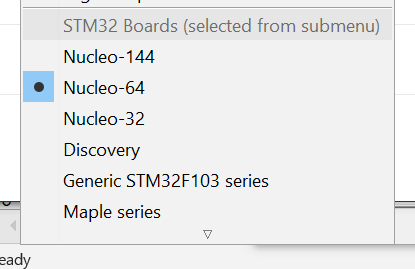When reading the various STM32 blogs and forum posts etc, there seems to be a very common theme that the Arduino IDE and/or stm32duino only caters for the F0 and F1’s, I think that may of been the case for a long time, but more recently it seems ST are involved with stm32duino and it is now an official ST offering. All those older discussions are not doing the current efforts any favors as I too believed the Arduino IDE wouldn’t do the F3’s but it seems it does.
Once you install the STM core using the boards manager (much like the esp8266 add-on) at the bottom of the boards menu list you see this

it seems to do each of the Nucleo board ranges (32, 64 and 144 pin mcu’s), the Discovery boards and the more common “F1” or “Maple” (Pills?)
We have Nucleo-64 boards with a F303 fitted but it seems the Arduino caters for most if not all of them. Interesting it does seem to be missing any F2’s, no idea why that might be. I assume the WICED libs are provided by an Adafruit’s boards library or other party?

I cannot make any recommendation or vouch for any of this as I’m just starting out on a learning curve myself, but our resident STM guru @dBC has convinced us the way to go is to use the STM32cubeMX utility to configure the HW as there are so many registries and peripherals to play with on these mcu’s, and that gives you a base to add your code to, as yet I have not found this to be Arduino compatible as such (it may be?) but compiling and flashing is as easy as
cd myproject
make
cp build/myproject.bin /dev/ttyACM0
because all the nulceo boards have a on-board/snap-off STlink v2.1 programmer board (STM32F103C8T6 based) that presents itself as a storage device over USB that you you can drag and drop a bin file to (GUI desktop) and it just flashes itself, and for command line you just use cp.
But the ST32cubeMX and drag’n’drop flash leave a bit of a gap between them that is where you write the code, as yet I’m unsure if that can be done in the Arduino IDE or if we can only use a text editor or visual code or atom etc.
For £10 quid for a 72MHz M4 with 4x12 bit adc’s capable of 5msps each or 18msps max overall for up to 22 channels and that includes a genuine (attached) STlink v2.1 programmer/debugger and postage.
https://uk.rs-online.com/web/p/processor-microcontroller-development-kits/8644009/?sra=pmpn
The other “IDE” option is platfomio, which does appear to have extensive libs for the STM range, but I cannot say what it’s like to use, I’ve not had much luck with it in the past, but today I did happen to test it could compile for a f303 on a Pi which it did do without problem. But it isn’t stricktly an IDE like the Arduino IDE is as such, it has plugins to use Atom or MS visual code editors, these you can of course use with the simple “make” option too.
See the STM32 Development for some more reading on the f303 or just the toolchains and utilities etc. I have no doubt there will be a lot more discussions on these.